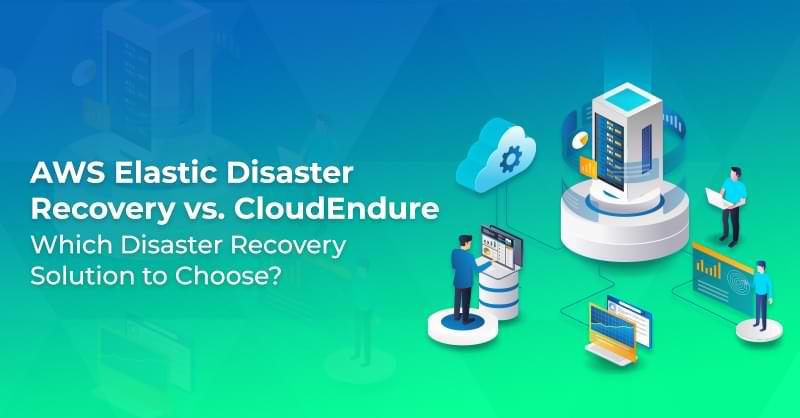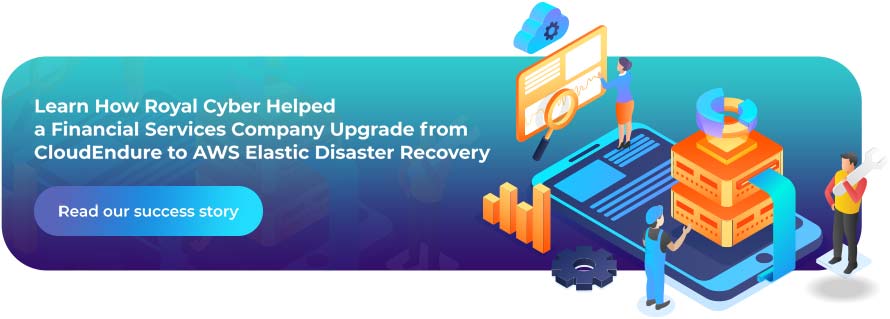AWS Elastic Disaster Recovery vs. CloudEndure: Which Disaster Recovery Solution to Choose?

Written by Priya George
Content Writer
September 21, 2022
Disaster Recovery (DR) and building a business continuity plan have become necessary for companies as the threats to their infrastructure increase daily. With cloud platforms, there is an increase in disaster recovery as a service (DRaaS) tools that prevent data loss and ensure reliable recovery, with a pre-set plan based on service level agreements.
Regarding DR solutions, AWS clients are spoiled for choice as two tools offer the same service: AWS CloudEndure and AWS Elastic Disaster Recovery.
Watch our video where we discuss Disaster Recovery on AWS. AWS CloudEndure offers two solutions: migration to the cloud and disaster recovery.
AWS CloudEndure Disaster Recovery is a solution that helps companies recover from app or infrastructure outages that occur due to accidents or malicious attacks. With block-level, continuous replication, companies can enable backup frequency of up to minutes. This feature ensures that companies can access the most recent version of their IT infrastructure.
AWS Elastic Disaster Recovery (AWS DRS) is the next-generation disaster recovery solution following AWS CloudEndure. This solution can be accessed from the AWS management console, enabling a more seamless experience for AWS clients as they can build custom solutions with the help of AWS DRS and AWS apps like CloudTrail, CloudWatch, etc. Furthermore, with Elastic Disaster Recovery, companies can recover applications from physical servers, VMs, and other cloud infrastructure and even set up an alternate AWS region as the DR site. In this blog, we highlight the differences between the two services and help developers decide which is the right choice for their company.
CloudEndure vs. AWS Elastic Disaster Recovery (AWS DRS)
When it comes to comparing the two disaster recovery services, it is best to compare along the lines of capabilities offered. In this blog, we compare the two services based on 20 essential capabilities that DR solutions need to possess.
- Operating Systems: Regarding who supports more operating systems, AWS CloudEndure has the edge on AWS Elastic Disaster Recovery. However, both these solutions support the two most popular operating systems: Microsoft Windows and Linux.
- Recovery Region Support: This is an important capability when deciding on DR sites. Yet again, AWS CloudEndure is advantageous as it supports GovCloud and China regions in addition to commercial regions. On the other hand, AWS Elastic Disaster Recovery (AWS DRS), a new service, only supports nine commercial regions.
- Console and APIs: This is an area where the AWS Elastic Disaster region has the edge over CloudEndure. As mentioned earlier, since AWS DRS is on the management console, it has direct access to the standard AWS APIs, CLI, and SDK.
- Resource Management: AWS Elastic Disaster Recovery allows direct access to launch settings and EC2 templates, unlike CloudEndure, which relies on legacy projects and blueprints and is thus not up to date on the latest EC2 updates.
- User Management and Monitoring: AWS DRS has direct access to the management console, which enables direct interaction between AWS services like IAM, AWS CloudTrail, Amazon CloudWatch, and Amazon EventBridge. DRS even offers temporary IAM credentials for agent installation. Thus, companies can enable granular access to resources, audit infrastructure, and monitor metrics and events effortlessly. In contrast, CloudEndure is more rigid, with three pre-set user profiles, only 52 events in a legacy format, and zero metrics for monitoring.
- Control Plane Availability: CloudEndure supports more regions; however, its control planes are tied to specific locations: for instance, the entire US region control plane is hosted in North Virginia, while Beijing hosts the control plane for the entire China region. AWS DRS has control planes hosted in every region supported; therefore, there is higher availability as there are zero cross-regional dependencies.
- Public Internet Access: One of the most significant vulnerabilities for cloud computing is that resources can be accessed via the public internet, a caveat CloudEndure faces. However, with AWS Elastic Disaster Recovery, companies can sidestep this issue by leveraging AWS PrivateLink and AWS Direct Connect for replication and failback. This helps make the DR solution that much more secure.
- Failback Testing: With CloudEndure, companies need to stop replication at the source server to test failback, but with AWS DRS, companies can carry out failback drills without disrupting the source server and the recovery point objective (RPO).
- Failback and Recovery: Both services have AWS region-to-region replication and recovery and failback; however, for the latter, companies need to carry out manual steps on AWS Elastic Disaster Recovery. Both solutions also offer large-scale failback automation.
- Compliance Support: CloudEndure supports a larger group of compliances, including GDPR, HIPAA, and ISO, while AWS DRS only supports GDPR. However, this is more due to the recent release of DRS, and it is only a matter of time before this service catches up or outstrips CloudEndure.
- Replication capabilities: With CloudEndure, developers can quickly start, stop and pause the data replication process. But with Elastic Disaster Recovery, developers need to reinstall/uninstall the DRS agent to start and stop the process as it does not have pause capabilities.
- Additional services: Compared to AWS DRS, CloudEndure possesses additional capabilities such as separate accounts for staging and launching, AWS VPC region-to-region stack, autodetection of added disks, and support for AWS Outposts.
In conclusion, when choosing between the two services, organizations must figure out their disaster recovery plan and its objectives, as choosing between the two requires trade-offs. Ideally, suppose you are a company that relies on legacy operating systems and requires recovery sites in locations such as China or GovCloud. In that case, it is recommended that you use CloudEndure Disaster Recovery. However, for newer AWS clients, given that AWS DRS has direct access to the AWS console, additional AWS services can be leveraged to make a more secure disaster recovery plan. Besides, since Elastic Disaster Recovery is a new service that was only launched in 2021, it is only a matter of time before it catches up. AWS now encourages clients to upgrade to AWS DRS unless prerequisites prevent the upgrade- an example would be the source server being incompatible with AWS DRS.
How to Upgrade from CloudEndure to AWS Elastic Disaster Recovery
Several steps need to be followed when it comes to upgrading from CloudEndure Disaster Recovery to AWS DRS:
- Validate the compatibility of the source servers with Elastic Disaster Recovery by following the procedure set by AWS. Upgrade eligibility is only possible for source servers that run on OS compatible with AWS DRS, or this service supports the recovery region.
- When the servers are validated, launch and set up the DRS service console in the AWS DR Region.
- Start the upgrade procedure, which imports the server configuration and consistent snapshots from CloudEndure to Elastic Disaster Recovery, and replaces the CloudEndure agent with the AWS Replication Agent.
- Once the machine is added to the Elastic Disaster Recovery console and the replication will begin.
- After completing the final replication, you can start “Initiate Drill” and test the DR process.
How can Royal Cyber Help?
In this blog, we have highlighted the differences between AWS CloudEndure and AWS Elastic Disaster Recovery (DRS) and the factors that drive the choice between the two services. However, implementing a DR plan and leveraging either of these services with ease is easier said than done. With our AWS-certified experts, companies can create custom DR solutions that meet their business needs. In addition to our consultation and managed services, our support services can also help conduct drills and ensure DR processes like failback and failover are running smoothly and companies are meeting their RPO and RTO cost-effectively.
For more information, visit our website www.royalcyber.com or contact us at [email protected].




